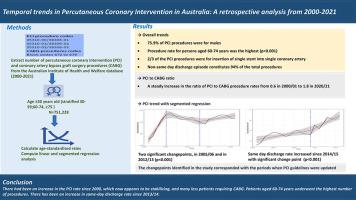Hellenic Journal of Cardiology ( IF 4.1 ) Pub Date : 2023-10-18 , DOI: 10.1016/j.hjc.2023.10.002 Netsanet B Kumsa 1 , Thu-Lan Kelly 1 , Elizabeth E Roughead 1 , Rosanna Tavella 2 , Marianne H Gillam 3

|
Objective
The aim of this study was to describe the trend in percutaneous coronary intervention (PCI) with insertion of stent in Australia from 2000/01 to 2020/21 and investigate trends in same-day versus non-same day discharge following PCI. A secondary aim was to compare the rate of coronary artery bypass grafting (CABG) with PCI procedures, while a third aim was to compare marked PCI trend changes with the PCI guidelines during the study period.
Background
PCI with stent deployment is the most common form of interventional treatment for coronary artery disease, and its use has been expanding since 2000. However, there is a lack of descriptive studies of the national trend in Australia.
Methods
All procedures for PCI and CABG were extracted across 21 years (2000/01 to 2020/21) from the Australian Institute of Health and Welfare data. Age-standardised rates were calculated using the Australian standard population as of June 2001. The ratio of PCI to CABG procedures was also calculated. Trends for PCI were stratified by age, gender, and same-day or overnight discharge episodes. Linear regression analysis was done to compare the age-standardised rates across different age categories. Segmented regression analysis was performed to ascertain the change in the age-standardised rates of PCI during the study period. Whether the changepoints in the trend were matched with guideline updates was also assessed.
Results
There were 751 728 PCI procedures in persons aged 30 years and above between 2000/01 and 2020/21. The age-standardised rate for the study period showed that persons aged 60-74 years had a higher rate of procedures (102.7) compared to persons aged 30-59 years (81.3) and 75 years and older (61.8) (P<0.001). There were two statistically significant changepoints in the overall trend;2005/06 and 2013/14, matched with the change in PCI guidelines. Despite the lower number of procedures for same-day discharge episodes there was an increasing trend since 2014/15. More than two-thirds of all stenting procedures were the insertion of single stent. PCI to CABG procedure ratio increased from 0.6 in 2000/01 to 1.8 in 2020/21.
Conclusions
There was a varying trend in the age-standardised rate of PCI with a peak in 2005/06. The trend appears to be stabilising in later part of the study period, but the rate for same day discharge episode showed an increasing trend after 2014/15. There is consistency with changepoints in the trend and updated PCI guideline recommendations. The ratio of PCI with insertion of stent to CABG procedure increased substantially across the study period.
中文翻译:

澳大利亚经皮冠状动脉介入治疗的时间趋势:2000-2021 年回顾性分析
客观的
本研究的目的是描述 2000 年 1 月至 2020 年 21 年间澳大利亚经皮冠状动脉介入治疗 (PCI) 植入支架的趋势,并调查 PCI 后当天出院与非当天出院的趋势。第二个目的是比较冠状动脉旁路移植术 (CABG) 与 PCI 手术的发生率,第三个目的是将研究期间显着的 PCI 趋势变化与 PCI 指南进行比较。
背景
PCI支架置入术是冠状动脉疾病介入治疗最常见的形式,自2000年以来其使用范围不断扩大。然而,缺乏对澳大利亚全国趋势的描述性研究。
方法
所有 PCI 和 CABG 手术均从澳大利亚健康与福利研究所的数据中提取,涵盖 21 年(2000/01 至 2020/21)。年龄标准化率是使用截至 2001 年 6 月的澳大利亚标准人口计算的。还计算了 PCI 与 CABG 手术的比率。PCI 的趋势按年龄、性别以及当天或夜间出院次数进行分层。进行线性回归分析以比较不同年龄类别的年龄标准化率。进行分段回归分析以确定研究期间年龄标准化 PCI 率的变化。还评估了趋势的变化点是否与指南更新相匹配。
结果
2000/01 至 2020/21 年间,30 岁及以上人士接受 PCI 手术的人数为 751 728 例。研究期间的年龄标准化率显示,60-74 岁人群的手术率 (102.7) 高于 30-59 岁人群 (81.3) 和 75 岁及以上人群 (61.8) (P<0.001) 。总体趋势有两个统计上显着的变化点:2005/06 和 2013/14,与 PCI 指南的变化相匹配。尽管当天出院的手术数量较少,但自 2014/2015 年以来呈增加趋势。超过三分之二的支架置入手术是插入单个支架。PCI 与 CABG 手术的比率从 2000/01 年的 0.6 增加到 2020/21 年的 1.8。
结论
年龄标准化 PCI 率存在变化趋势,在 2005/2006 年达到峰值。在研究后期,这一趋势似乎趋于稳定,但 2014/2015 年之后,当天出院率呈上升趋势。趋势变化点和更新的 PCI 指南建议具有一致性。在整个研究期间,PCI 置入支架与 CABG 手术的比率大幅增加。



























 京公网安备 11010802027423号
京公网安备 11010802027423号